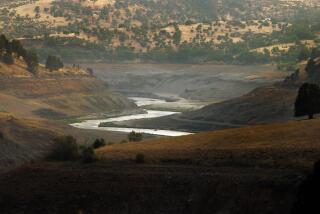Some Tender Memories of a Home : Reservoir: The longtime guardian of Casitas Dam is losing his house. A water treatment facility will be built in its place.
- Share via
Dwight Clements is giving up his home so Casitas Municipal Water District customers can drink cleaner water.
Clements, who has lived a stone’s throw from Casitas Dam since he became the dam tender in 1978, is being displaced by a water treatment facility.
The water district was ordered in 1987 to bring Lake Casitas water up to state and federal drinking-water standards by 1992. To do that, a $27.8-million water treatment facility will be built downhill from the dam, so water can flow down to it rather than being pumped.
Unfortunately for Clements, 48, his home of more than 13 years is downhill from the dam.
He is slowly facing up to the inevitable. “We’re just going to have to relocate my house,” he said.
Standing in the winding driveway that leads to Clements’ light-green, single-story home, it is possible to see the retaining wall of Casitas Dam, which serves 56,500 customers in Ventura, the upper Ojai Valley and the Rincon area.
Although the wall is all that stands between thousands of Ventura County residents and millions of gallons of water, Clements says he never thought of living anywhere else while serving as the dam tender.
“This is just a neat old house,” Clements said. “It was an old farmhouse at one time. It’s full of little cubbyholes, and all those memories. Our three kids grew up here.”
Ask Clements about Lake Casitas and he talks about the last time that the dam flowed over the retaining wall, in 1986, or about teaching his children to fish there years ago. Question him about the surrounding wilderness and he weaves yarns of raccoons, bobcats, bears and mountain lions.
All that is likely to change after his house is demolished later this year, when preliminary construction begins in preparation for the massive treatment facility, he admits.
“They’re going to level that whole hill, I guess, and the house will probably go up above both the treatment plant and the dam,” Clements said.
Clements is a bit sad that the new three-bedroom dwelling probably will bear little resemblance to his well-worn home, but he says both will share one key trait--proximity to the dam.
Dam tenders at Lake Casitas have always lived next to the facility, primarily because the Bureau of Reclamation classifies the reservoir as high-risk, said Jim Weber, electrical and mechanical supervisor for the district.
The classification does not speak of the dam itself, but of the potential damage that a massive rupture would cause to people and property below the dam, Weber said.
Despite the classification, Clements said he has no fear of the dam itself. “It would take an earthquake that would move those mountains to do damage to that dam,” he said.
Clements’ daily routine begins early in the morning, when he checks key areas of the dam for signs of damage.
Later in the day, he monitors a series of measuring devices that attest to the dam’s health and monitor the chlorination system that makes the water drinkable.
“I’ve been on every part of the dam and a part of every conceivable test they’ve ever done here, so at this point I’m really confident in it,” Clements said.
Even at night, the dam tender’s work is not through. It is Clements’ responsibility to deal with trespassers, usually fishermen and couples looking for a rendezvous spot.
“To be honest, that’s the part of the job I like least,” he said. His uniform--a tan ranger shirt with a Casitas Dam Tender badge and khaki pants--is supposed to persuade trespassers of his authority, he said.
“I live in here, so I don’t want these people to just come strolling up to my house,” he said.
The treatment facility, which is in the design phase, will offer more of a buffer between the public and his home, Clements said.
Clements is taking a stoic view of the impending move. “This treatment facility is mandated by the state--it isn’t a matter of whether people want it or not.”
More to Read
Sign up for Essential California
The most important California stories and recommendations in your inbox every morning.
You may occasionally receive promotional content from the Los Angeles Times.













